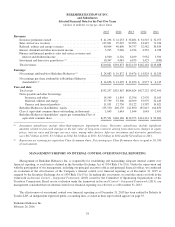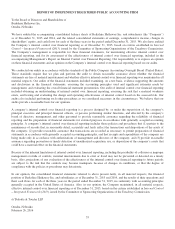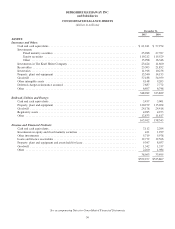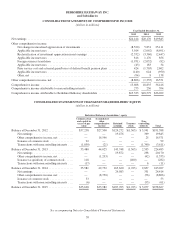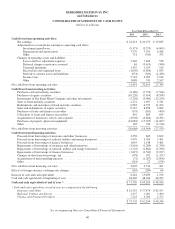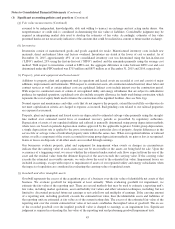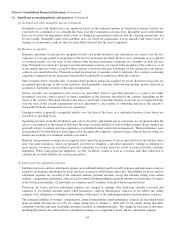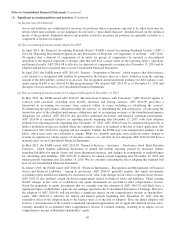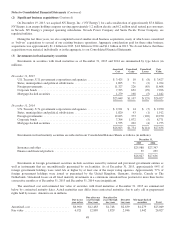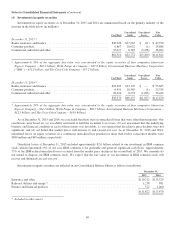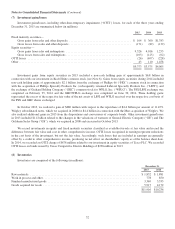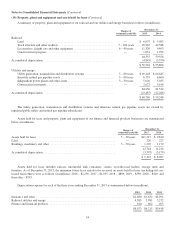Berkshire Hathaway 2015 Annual Report Download - page 46
Download and view the complete annual report
Please find page 46 of the 2015 Berkshire Hathaway annual report below. You can navigate through the pages in the report by either clicking on the pages listed below, or by using the keyword search tool below to find specific information within the annual report.Notes to Consolidated Financial Statements (Continued)
(1) Significant accounting policies and practices (Continued)
(j) Goodwill and other intangible assets (Continued)
Intangible assets with definite lives are amortized based on the estimated pattern in which the economic benefits are
expected to be consumed or on a straight-line basis over their estimated economic lives. Intangible assets with definite
lives are reviewed for impairment when events or changes in circumstances indicate that the carrying amount may not
be recoverable. Intangible assets with indefinite lives are tested for impairment at least annually and when events or
changes in circumstances indicate that it is more likely than not that the asset is impaired.
(k) Revenue recognition
Insurance premiums for prospective property/casualty and health insurance and reinsurance are earned over the loss
exposure or coverage period in proportion to the level of protection provided. In most cases, premiums are recognized
as revenues ratably over the term of the contract with unearned premiums computed on a monthly or daily pro-rata
basis. Premiums for retroactive property/casualty reinsurance policies are earned at the inception of the contracts, as all
of the underlying loss events covered by these policies occurred in the past. Premiums for life reinsurance and annuity
contracts are earned when due. Premiums earned are stated net of amounts ceded to reinsurers. For contracts containing
experience rating provisions, premiums earned reflect estimated loss experience under the contracts.
Sales revenues derive from the sales of manufactured products and goods acquired for resale. Revenues from sales are
recognized upon passage of title to the customer, which generally coincides with customer pickup, product delivery or
acceptance, depending on terms of the sales arrangement.
Service revenues are recognized as the services are performed. Services provided pursuant to a contract are either
recognized over the contract period or upon completion of the elements specified in the contract depending on the
terms of the contract. Revenues related to the sales of fractional ownership interests in aircraft are recognized ratably
over the term of the related management services agreement as the transfer of ownership interest in the aircraft is
inseparable from the management services agreement.
Leasing revenue is generally recognized ratably over the term of the lease, as a substantial portion of our leases are
classified as operating leases.
Operating revenues from the distribution and sale of electricity and natural gas to customers are recognized when the
services are rendered or the energy is delivered. Revenues include unbilled as well as billed amounts. Rates charged are
generally subject to federal and state regulation or established under contractual arrangements. When preliminary rates
are permitted to be billed prior to final approval by the applicable regulator, certain revenue collected may be subject to
refund and a liability for estimated refunds is recorded.
Railroad transportation revenues are recognized based upon the proportion of service provided as of the balance sheet
date. Customer incentives, which are primarily provided for shipping a specified cumulative volume or shipping to/
from specific locations, are recorded as pro-rata reductions to revenue based on actual or projected future customer
shipments. When using projected shipments, we rely on historic trends as well as economic and other indicators to
estimate the recorded liability for customer incentives.
(l) Losses and loss adjustment expenses
Liabilities for losses and loss adjustment expenses are established under property/casualty insurance and reinsurance contracts
issued by our insurance subsidiaries for losses that have occurred as of the balance sheet date. The liabilities for losses and loss
adjustment expenses are recorded at the estimated ultimate payment amounts, except that amounts arising from certain
workers’ compensation reinsurance contracts are discounted. Estimated ultimate payment amounts are based upon (1) reports
of losses from policyholders, (2) individual case estimates and (3) estimates of incurred but not reported losses.
Provisions for losses and loss adjustment expenses are charged to earnings after deducting amounts recovered and
estimates of recoverable amounts under ceded reinsurance contracts. Reinsurance contracts do not relieve the ceding
company of its obligations to indemnify policyholders with respect to the underlying insurance and reinsurance contracts.
The estimated liabilities of workers’ compensation claims assumed under certain reinsurance contracts are discounted based
upon an annual discount rate of 4.5% for claims arising prior to January 1, 2003 and 1% for claims arising thereafter,
consistent with discount rates used under insurance statutory accounting principles. The change in such reserve discounts,
including the periodic discount accretion is included in earnings as a component of losses and loss adjustment expenses.
44


